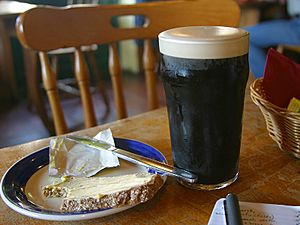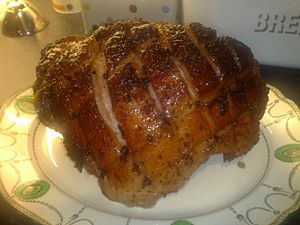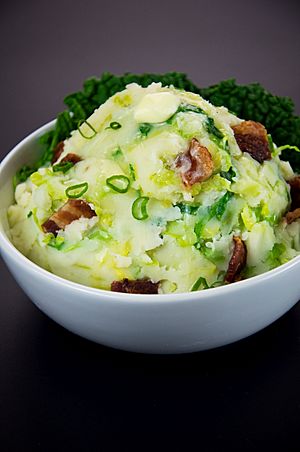Irish cuisine facts for kids
Irish cuisine is the special way of cooking that comes from the island of Ireland. It has changed a lot over hundreds of years because of social changes, political events, and different cultures mixing, especially from nearby Britain and other parts of Europe.
Irish food uses ingredients found on the island. These include crops and animals raised in its mild climate, and lots of fresh fish and seafood from the Atlantic Ocean. For example, tasty fish chowder is popular along the coasts.
A big change happened in Irish food when the English took over Ireland in the early 1600s. This led to more land being used for growing grains. These grains and meats were often sent abroad to feed soldiers and people in the British Empire. Because of this, potatoes became very important in the 1700s. They were cheap and easy to grow, becoming the main food for most poor people.
Today, many traditional Irish dishes are being brought back. These include famous meals like Irish stew, bacon and cabbage, boxty, soda bread, coddle, and colcannon. Modern Irish chefs still use these classic ingredients but cook them with new ideas from around the world. They present the food in a more modern and artistic way.
Contents
History of Irish Food
Old Irish stories and writings often mention food and drink. For example, the tale of Fionn mac Cumhaill and the Salmon of Knowledge talks about food. These old stories also describe big feasts with special portions for heroes and meat cooked in large pots or on spits over a fire.
Irish traditions share many foods with other ancient European cultures. For instance, honey was always important. It was used to make mead, a drink found in many old myths and rituals from Ireland to India.
Food in Prehistoric Ireland
Stone Age (Mesolithic Period: 8000–4000 BC)
Before farming began in Ireland, people were hunter-gatherers. They ate a mix of plants and animals. We know this from old stone tools, animal bones, and even from studying human teeth and bones.
People who lived near water ate a lot of fish, shellfish, and small animals. They also gathered plants. Large piles of shells, called middens, show that shellfish like oysters and limpets were a big part of their diet. The town name Sligo, meaning "abounding in shells," shows how common shellfish were there.
Because Ireland is an island, its early people had a unique diet. They ate wild boar, which was brought to Ireland by early settlers. They also gathered crowberries, raspberries, blackberries, water-lily seeds, tubers, apples, and hazelnuts. Hazelnuts were so important that they might have even been used as money.
These early Irish people knew how to manage their food sources. They hunted boar carefully and understood how tides worked to gather shellfish at the best times. They used simple fishing methods like traps and nets. They also cooked food by roasting it over fires or on hot rocks.
Early Farming Age (Neolithic Period: 4000-2500 BC)
During the Neolithic period, farming changed how Irish people ate. They started growing crops like emmer wheat and barley. They also raised animals like cattle, pigs, and goats. This meant they ate less seafood than before.
Cattle bones found at old sites suggest that beef was eaten in large amounts, maybe during big community gatherings. Hazelnuts were still common, but their importance slowly decreased.
New ways of cooking also appeared. People used burnt stone mounds, called fulachtaí fia, for cooking. These were places where stones were heated and then used to boil, steam, or bake food.
Bronze Age (2000-500 BC)
Cooking with hot stones in fulachtaí fia became very popular in the Bronze Age. These sites were often used to boil meat, especially from farm animals like sheep, pigs, and cattle. Boiling helped keep the meat moist and get marrow from bones.
These large cooking sites were likely used for social gatherings. Cooking big meals would have taken many people working together, showing that food was a community activity.
Food in Gaelic Ireland
Customs and Kitchen Tools
In ancient Ireland, welcoming guests was very important. Landowners had to offer food to kings, bishops, or judges. People believed bad things would happen if they turned someone away.
The main meal was eaten in the afternoon or evening. A special meal at night, often with beer, was called a feis. The most important cooking tool was the cauldron, a large pot used for making stews and broths.
Meals usually included bread, fresh milk, or fermented milk like yogurt or cheese. These were eaten with a "relish" (anlann or tarsunn) made of vegetables, salted meat, or honey. Important guests received more relishes.
Grains
Before potatoes arrived in the 1500s, grains like oats, wheat, and barley were the main foods. They were cooked as porridge or made into bread. Oat flatbreads were very common. Wheat bread was a luxury for rich people.
Porridge was made from oats, barley, or wheat mixed with water, buttermilk, or fresh milk. It was often served with salted butter, fresh butter, or honey.
Meat
Meat was usually cooked fresh or salted and boiled in a cauldron. Sometimes it was flavored with honey. Meat was also roasted over a fire on wooden spits, similar to kebabs.
Eating meat was forbidden on Wednesdays and Fridays, and during Lent, for religious reasons. Pigs were a very common source of meat. They were fed acorns in forests. Salted pork sausages were also eaten.
Cattle were mostly kept for milk, but young male cattle were often killed for meat. Salted beef was a common stew ingredient. Offal (organs) like tripe were also used. Fish was sometimes grilled. Horse and crane meat were forbidden.
Dairy Products
Ireland has always been good at producing dairy because of its green pastures. Milk, butter, curds, and cheese were key parts of the ancient Irish diet. "White foods" (bánbia) was the name for dairy products.
People even mixed cattle blood with milk and butter. Black pudding, made from blood, grain, and seasoning, is still a popular breakfast food today. Honey was also important, especially for medicine.
"Bog butter" was butter stored in bogs (wetlands) to keep it fresh and let it age.
Fruits and Vegetables
Irish people grew and ate onions, chives, cabbage, celery, and leeks. Wild plants like watercress, sorrel, and nettles were gathered and added to broths.
Apples, pears, cherries, and plums were the most common fruits. Peas, broad beans, and lentils were grown after the Normans arrived. Hazelnuts were very important. Wild berries like bilberries and blackberries were also picked.
Pepper was known in Ireland from early Christian times, brought in from the Roman Empire.
Drinks
People used wooden cups or drinking horns. Fermented milk was a common drink. Beer, usually made from barley, was important for noble households.
Whiskey, called uisce beatha (water of life) in Irish, was invented in the Gaelic world after distilling began in the 1100s.
Religious Diets
Some monks ate vegetarian diets, though it wasn't always required. If they ate meat, it was usually wild pig or deer. Monks often ate a simple gruel made with water or milk and meal. On Sundays and festivals, they added fruits, nuts, and honey.
Food in Medieval Ireland (5th-15th Century AD)
The growth of towns in medieval Ireland changed food systems. People in towns relied on markets and farms for food, rather than hunting or growing it themselves. New foods also arrived through trade.
Laws in medieval Ireland sometimes decided what foods different classes of people could eat. For example, lower-class people could eat barley, oats, and dairy. Higher classes had access to wheat and beef, which were seen as more valuable. Wild game like venison was considered common food because anyone could hunt it.
Peasants were not usually entitled to special foods. However, during sickness, pregnancy, or injury, people were allowed more nutritious foods. Pregnant women were allowed any food they craved to prevent miscarriage. Children were given soft foods like eggs, porridge, and curds.
Cow and goat milk were more highly valued than sheep's milk. Common birds were for commoners, while rare birds like swans were for royalty.
Oats were considered "poor" food but were valued for being nutritious and easy to digest. They were a staple for children and horse feed. Wheat was difficult to grow in Ireland but was important for the upper classes and for making the Catholic sacramental Host.
Fruits, nuts, and vegetables were important seasonal additions to the diet. Apples were often cooked into puddings or fermented into drinks. People preserved fruits by drying, pickling, or making relishes with honey. Hazelnuts were still common and ground into a meal.
Wine was imported from France and England, especially for church feasts.
Food After Medieval Times
By 1840, potatoes were the main food for most Irish people, especially the poor. This was unusual because many parts of Europe avoided potatoes for a long time. Potatoes were easy to grow and provided lots of energy and vitamins. The diet of poor people was mainly potatoes and buttermilk.
Ireland also produced a lot of salted beef, but almost all of it was sent abroad to feed the British navy and army. This "corned beef" became associated with Irish people in America, but it wasn't a traditional food in Ireland itself.
Fresh meat was a luxury until the late 1800s. Many families kept a pig, which was called the "gentleman that pays the rent" because it could be sold or cured for ham and bacon to last through winter.
The Great Famine
In 1845, the Great Famine began. A mold caused potato blight, which destroyed potato crops. This made many poor people even poorer. The crops failed year after year.
Starving people tried to eat the diseased potatoes and became very sick. They started eating eggs, birds, and wild plants like nettles. Some farmers even bled their cattle and fried the blood with herbs and oats, as the meat was too unhealthy to eat. In extreme desperation, people ate rats and worms.
After the Famine
After the famine, many Irish women moved to America to escape poverty. They found new foods there and learned to cook for American upper-class families. At first, they struggled because they were used to different ingredients. This led to some unfair opinions about Irish cooking skills.
However, Irish women soon learned to use the ingredients available in America. They started to make Irish dishes with more meat and fruit. This helped change Irish food from being just about getting enough calories to being about pleasure and taste.
Modern Irish Food
Today, Ireland has adopted many foods popular in the Western world. You can find pizza, curry, Chinese, Thai, and even some West African and Eastern European dishes.
At the same time, a new Irish cuisine has grown. It uses traditional ingredients in fresh ways. This food focuses on fresh vegetables, fish like salmon and trout, oysters, mussels, traditional soda bread, and the many new cheeses made in Ireland. And, of course, the potato is still important!
Classic dishes like Irish stew, coddle, the full Irish breakfast, and potato bread are popular again. Chefs like Myrtle Allen helped lead this movement.
Fish and chips are a very popular take-away food. The first fish and chips were sold in Dublin in the 1880s by an Italian immigrant. In some northern parts of Ireland, fish and chips are called a "fish supper," and the shop is called a "chippy."
However, the rise of fast food has also led to health problems like obesity in Ireland. The government has tried to fight this with advertising and school programs.
Common Foods in Ireland
- Dairy: butter, milk, buttermilk, cheese
- Grains: barley, oats, wheat
- Freshwater fish: pollan, trout, salmon, smoked salmon, smoked trout
- Seafood: mackerel, cod, hake, haddock, smoked haddock, mussels, oysters, lobster, crab, sea vegetables (seaweeds), dillisk
- Meat: beef, chicken, lamb, pork, turkey, goose, offal (organs)
- Vegetables: curly kale, potatoes, carrots, onions, cabbage, rhubarb
- Fruits: apple, pear, plum, blackberry, strawberry, raspberry, tomatoes
- Herbs: parsley, thyme, rosemary, chives
- Spices: cinnamon, nutmeg, mixed spice, black pepper
Traditional Irish Foods
Breads
- Bairín Breac (Barmbrack)—a currant cake with a golden ring inside. It's traditionally eaten around Halloween.
- Blaa—a soft, white bread bun from Waterford.
- Goody—a sweet dessert dish.
- Indian Meal Bread—a soda bread made with corn (maize).
- Oatcake
- Potato bread
- Soda bread—a popular bread made without yeast.
- Soda farl—a traditional food in Ulster, especially in Northern Ireland.
- Veda bread
- Wheaten bread
Pork Dishes
- Bacon and cabbage
- Black pudding—a traditional dish made from pig's blood, barley, and seasoning.
- Coddle—a stew with pork sausage, bacon, and potato.
- Crubeens—pig's trotters (feet).
- Skirts and kidneys—a type of pork stew.
- White Pudding—made with suet, oatmeal or barley, and pork meat or liver.
Potato Dishes
- Boxty—a type of potato pancake.
- Champ—mashed potatoes with scallions (green onions), butter, and milk.
- Colcannon—mashed potatoes with kale or cabbage and butter.
- Shepherd's Pie/Cottage Pie—mashed potato topping over minced lamb (Shepherd's) or beef (Cottage) and vegetables.
Seafood
Even though Ireland has a huge coastline, people don't eat as much seafood as in some other countries. In the past, seafood was sometimes seen as food for the poor or for religious fasting days. However, eating fresh fish and seafood is becoming popular again.
In Dublin, a fish seller is celebrated in the folk song Molly Malone. Galway hosts an international Oyster Festival every September. Dublin Lawyer is a modern Irish dish of lobster cooked in whiskey and cream. Salmon and cod are very common fish. Seaweeds like Carrageen moss and dulse are also used in Irish seafood dishes.
Seaweed has always been an important part of the Irish diet and is still popular today.
Other Traditional Dishes
- Breakfast roll
- Drisheen—a type of black pudding.
- Irish breakfast—a big cooked breakfast.
- Irish stew—a lamb stew.
- Porridge
Traditional Irish Drinks
Alcoholic Drinks
- Whiskey (especially pure pot still whiskey) like Jameson and Bushmills.
- Porter or stout like Guinness and Murphy's.
- Irish red ale like Smithwick's.
- Lager
- Irish coffee, made with strong black coffee, whiskey, sugar, and whipped cream.
- Irish cream like Baileys.
- Irish Mist
- Mead
- Poitín, a strong spirit.
- Cider, like Magners / Bulmers.
Non-alcoholic Drinks
- Brown lemonade
- Red Lemonade—an Irish fizzy soft drink.
- Cavan Cola
- McDaid's Football Special
- Irish breakfast tea
- Cidona
- Tanora
- Club (soft drink)
Irish Chefs
- Myrtle Allen
- Darina Allen
- Rachel Allen
- Neven Maguire
- Catherine Fulvio
- Derry Clarke
- Richard Corrigan
- Denis Cotter
- Trish Deseine
- Kevin Dundon
- Dylan McGrath
- Dan Mullane
- Éamonn Ó Catháin
- Paul Rankin
- Kevin Thornton
- Dónal Skehan
See also
 In Spanish: Gastronomía de Irlanda para niños
In Spanish: Gastronomía de Irlanda para niños









